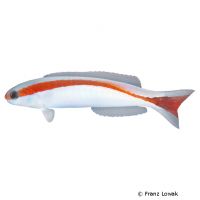Redback Sand Tilefish (Hoplolatilus marcosi)
| Redback Sand Tilefish Hoplolatilus marcosi | |
|---|---|
| Name | Redback Sand Tilefish |
| Name Lat. | Hoplolatilus marcosi |
| Family | Tilefishes |
| Family lat. | Malacanthidae |
| Order | Eupercarias |
| Order lat. | Eupercaria inc. sed. |
| Origin | Indo-West Pacific |
| Habitat | Coral reefs |
| Diet | Carnivore |
| pH | 8.1-8.4 |
| Hardness | 8-10 °KH |
| Behavior | Peaceful |
| Keeping | Pair |
| Reef Compatible | Yes |
| Care Level | Difficult |
| Life Span | N/A |
| Protection | No |
| Metric Units | |
| Size | 12 cm |
| Temperature | 22-27 °C |
| Salinity | 33-36 ‰ |
| Aquarium | ~ 300 l |
| US Units | |
| Size | 5" |
| Temperature | 72-81 °F |
| Salinity | 1.020-1.025 sg |
| Aquarium | ~ 80 gal |
Distribution and habitat
The distribution area of Hoplolatilus marcosi reaches from the Philippines and Papua New Guinea over Indonesia to the Solomon Islands. They live there mainly on sand and rubble bottoms of coral reefs, where they stay in self-dug living caves, mostly under stones in 18 - 80 m depth.
Maintenance
They require a well-structured aquarium with rock structures that provide numerous hiding and cover opportunities and plenty of free swimming space, as well as a sand substrate that is at least 7 cm deep and suitable for digging.
Only lime-rich, heavy metal-free substrates may be used as substrate. To ensure water quality, filters, skimmers and heaters are necessary, as well as pumps to simulate tides, swells and bottom currents. It is recommended that live stones be used to set up the aquarium. The bacteria living in the porous stones act as a biological filter. The lighting must correspond to the species-appropriate day-night rhythm of the animals
| Salinity: 33-36 ‰ | pH value: 8.1-8.4 |
| Carbonate hardness: 8-10 °KH | Nitrate content: 2-8 mg/l |
| phosphate content: 0.01-0.1 mg/l | nitrite content: 0.0-0.05 mg/l |
For salinity, an average value should be aimed for, which may only vary slightly by +/- 0.5 ‰. Ammonia and ammonium must not be measurable. Special attention must be paid to constantly good water quality.
Diet
In nature they feed mainly on zooplankton. The feed conversion does not always succeed without problems. The diet consists of a combination of live and frozen foods, such as small mysis and artemia, with chopped shrimp and crab meat, or a commercially available vitamin-enriched frozen food mix for planktivores. High-quality flake and granulated food is also often accepted after an acclimation period
It is recommended to feed small portions several times a day. Regular and varied feeding promotes health and increases resistance.
Behaviour and compatibility
It is recommended to keep these peaceful and shy fish in pairs. Multiple pairs should only be kept in a much larger, richly structured tank. A socialization with invertebrates and other calm, peaceful fish is well possible.
Sex dimorphism
There are no known external distinguishing characteristics. They are protogynous hermaphrodites, i.e. most males develop from functional females when needed.
Reproduction and breeding
There are no known reports of successful breeding in the aquarium.
Important
They are skittish and jump well, so the aquarium should always be well covered. Stone structures must be well anchored, because they like to dig.
As coral reef dwellers, they should not be kept in a fish-only aquarium
If different species are kept together, care should be taken to ensure that the fish are compatible in terms of water quality and temperature requirements and social behavior, and that the setup meets the needs of all species kept together. New fish to be introduced must be acclimated slowly to the water in the aquarium
Further literature can be found in your pet store.
References
Text: Werner Winter; Image: Franz Lowak
Source: KUITER, DEBELIUS (2007): Atlas der Meeresfische: Die Fische an den Küsten der Weltmeere, Kosmos Verlag; BAENSCH & DEBELIUS (2006): Meerwasser Atlas Bd. 1, Mergus Verlag; ENGELMANN (2005): Zootierhaltung - Tiere in menschlicher Obhut: Fische, Verlag Harri Deutsch
- Gemäß § 21 Abs. 5 Tierschutzgesetz idgF
